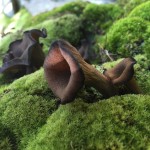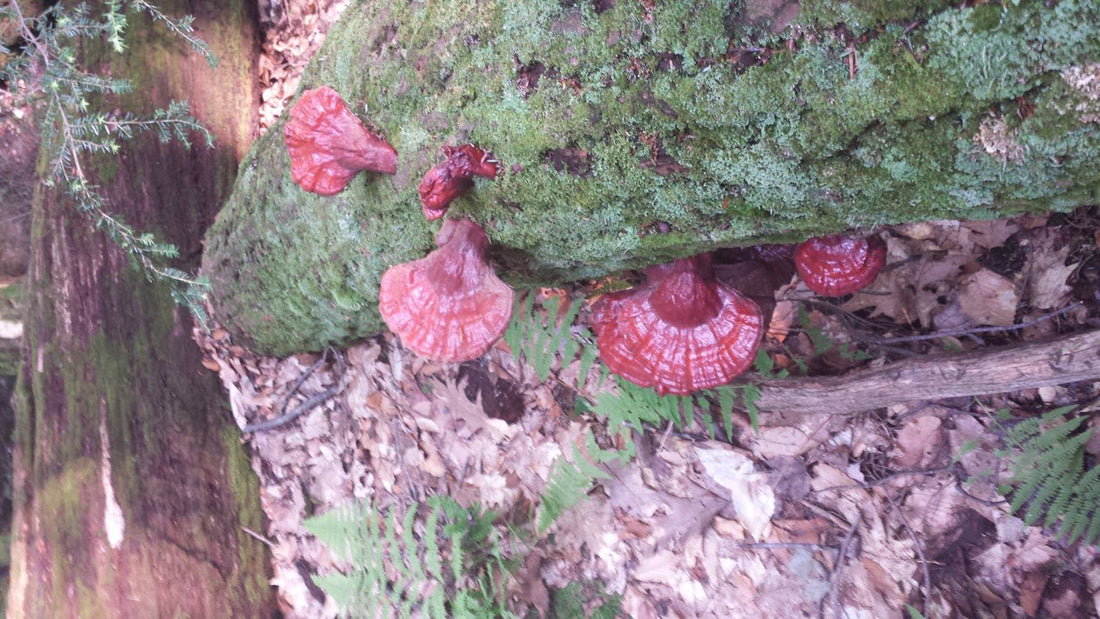Foraging mushrooms is an amazing way to connect with the fungal kingdom
Mushrooms are consistently in motion in the world around us and by opening our eyes to fungi we can start to see their abundance. The best time to go out foraging mushrooms is between April and November in New England. There are many different varieties of mushrooms that fruit in the landscape around us. When you are just starting to forage it is good to learn five to ten mushroom species that can be confidently identified.
Top five foraging mushrooms
1. Black trumpets .
. This is a small black vase-shaped mushroom. It fruits from July-September. Found primarily in mossy banks along trails, or slopes where water has recently traveled.
A delicious mushroom that dries well and has a very pungent smell. These mushrooms tend to grow in large groups, that are extremely exciting to find while foraging mushrooms.
2. Chicken of the woods. This mu

shroom can get huge and is very obvious when seen in the woods. It has a bright orange top and the bottom is yellow with pores. Shown here is a young chicken of the woods, notice the swollen margin and the orange just starting to cover the top. This mushroom will more than triple in size. Foraging chicken of the woods is best done in oak forests. Dead, dying, or sometimes even healthy looking trees are infected with the mycelium. Fruiting happens from May through October but most abundantly in August-October.
3. Maitake or Hen of the woods is the third mushroom to start with if beginning foraging mushrooms.
Maitake or Hen of the woods is the third mushroom to start with if beginning foraging mushrooms. This mushroom fruits exclusively on oak on the east coast of United States. It typically fruits out of the ground at the base of old living or dying oak trees. Sometimes it can be found at the base of trees that recently fell down or died. This mushroom fruits from a single stem and has many overlapping fronds. It ranges on the spectrum of black to white in coloring on the top and has white pores on the underside. It is best picked on the younger side as many bugs tend to get inside with older age.
 4. Wine cap mushrooms are a massive mushroom that grows in New England around April and again in September.
4. Wine cap mushrooms are a massive mushroom that grows in New England around April and again in September. Of all the foraging mushrooms you can find this one is very unique because it can easily be cultivated. By transplanting the mycelium found in the leaf litter or wood chips into fresh wood chips or cardboard these mushrooms can be continually grown. You can also cut off the stem butt and transplant that into compost, wood chips, or cardboard. This mushroom is similar to portobello in taste, size and texture. It has a burgundy to white (if it is in the sun) cap and the underside is purple-black gills. There is usually a partial veil present and the stem is thick and white, tasting like asparagus! You can also grow this mushroom by
ordering spawn.
 5. When foraging mushrooms reishi is a great mushroom to know and search for.
5. When foraging mushrooms reishi is a great mushroom to know and search for. It is very distinct, having a bright red varnished look to it. It goes through an amazing transformation being all white initially then turning a vibrant yellow before a deep red. There are two different primary types of reishi found in New England. Hemlock reishi which fruits in May-July on dead hemlock, and reishi which grows on hardwoods in September and October. When young and all white this mushroom can be cooked and consumed. When it is older it can be cut, dried, and
used as medicine.
Foraging mushrooms can be very rewarding. Sometimes you are rewarded with an abundance of mushrooms, which always feels like a blessing bestowed from a higher power. Other times you may just have had the pleasure of seeing some mushrooms you hadn't noticed before and a nice walk in the woods. Either way, foraging mushrooms is a great activity for the body, heart, and soul.


 . This is a small black vase-shaped mushroom. It fruits from July-September. Found primarily in mossy banks along trails, or slopes where water has recently traveled. A delicious mushroom that dries well and has a very pungent smell. These mushrooms tend to grow in large groups, that are extremely exciting to find while foraging mushrooms.
2. Chicken of the woods. This mu
. This is a small black vase-shaped mushroom. It fruits from July-September. Found primarily in mossy banks along trails, or slopes where water has recently traveled. A delicious mushroom that dries well and has a very pungent smell. These mushrooms tend to grow in large groups, that are extremely exciting to find while foraging mushrooms.
2. Chicken of the woods. This mu shroom can get huge and is very obvious when seen in the woods. It has a bright orange top and the bottom is yellow with pores. Shown here is a young chicken of the woods, notice the swollen margin and the orange just starting to cover the top. This mushroom will more than triple in size. Foraging chicken of the woods is best done in oak forests. Dead, dying, or sometimes even healthy looking trees are infected with the mycelium. Fruiting happens from May through October but most abundantly in August-October.
3.
shroom can get huge and is very obvious when seen in the woods. It has a bright orange top and the bottom is yellow with pores. Shown here is a young chicken of the woods, notice the swollen margin and the orange just starting to cover the top. This mushroom will more than triple in size. Foraging chicken of the woods is best done in oak forests. Dead, dying, or sometimes even healthy looking trees are infected with the mycelium. Fruiting happens from May through October but most abundantly in August-October.
3. Maitake or Hen of the woods is the third mushroom to start with if beginning foraging mushrooms. This mushroom fruits exclusively on oak on the east coast of United States. It typically fruits out of the ground at the base of old living or dying oak trees. Sometimes it can be found at the base of trees that recently fell down or died. This mushroom fruits from a single stem and has many overlapping fronds. It ranges on the spectrum of black to white in coloring on the top and has white pores on the underside. It is best picked on the younger side as many bugs tend to get inside with older age.
Maitake or Hen of the woods is the third mushroom to start with if beginning foraging mushrooms. This mushroom fruits exclusively on oak on the east coast of United States. It typically fruits out of the ground at the base of old living or dying oak trees. Sometimes it can be found at the base of trees that recently fell down or died. This mushroom fruits from a single stem and has many overlapping fronds. It ranges on the spectrum of black to white in coloring on the top and has white pores on the underside. It is best picked on the younger side as many bugs tend to get inside with older age.
 4. Wine cap mushrooms are a massive mushroom that grows in New England around April and again in September. Of all the foraging mushrooms you can find this one is very unique because it can easily be cultivated. By transplanting the mycelium found in the leaf litter or wood chips into fresh wood chips or cardboard these mushrooms can be continually grown. You can also cut off the stem butt and transplant that into compost, wood chips, or cardboard. This mushroom is similar to portobello in taste, size and texture. It has a burgundy to white (if it is in the sun) cap and the underside is purple-black gills. There is usually a partial veil present and the stem is thick and white, tasting like asparagus! You can also grow this mushroom by ordering spawn.
4. Wine cap mushrooms are a massive mushroom that grows in New England around April and again in September. Of all the foraging mushrooms you can find this one is very unique because it can easily be cultivated. By transplanting the mycelium found in the leaf litter or wood chips into fresh wood chips or cardboard these mushrooms can be continually grown. You can also cut off the stem butt and transplant that into compost, wood chips, or cardboard. This mushroom is similar to portobello in taste, size and texture. It has a burgundy to white (if it is in the sun) cap and the underside is purple-black gills. There is usually a partial veil present and the stem is thick and white, tasting like asparagus! You can also grow this mushroom by ordering spawn.
 5. When foraging mushrooms reishi is a great mushroom to know and search for. It is very distinct, having a bright red varnished look to it. It goes through an amazing transformation being all white initially then turning a vibrant yellow before a deep red. There are two different primary types of reishi found in New England. Hemlock reishi which fruits in May-July on dead hemlock, and reishi which grows on hardwoods in September and October. When young and all white this mushroom can be cooked and consumed. When it is older it can be cut, dried, and used as medicine.
Foraging mushrooms can be very rewarding. Sometimes you are rewarded with an abundance of mushrooms, which always feels like a blessing bestowed from a higher power. Other times you may just have had the pleasure of seeing some mushrooms you hadn't noticed before and a nice walk in the woods. Either way, foraging mushrooms is a great activity for the body, heart, and soul.
5. When foraging mushrooms reishi is a great mushroom to know and search for. It is very distinct, having a bright red varnished look to it. It goes through an amazing transformation being all white initially then turning a vibrant yellow before a deep red. There are two different primary types of reishi found in New England. Hemlock reishi which fruits in May-July on dead hemlock, and reishi which grows on hardwoods in September and October. When young and all white this mushroom can be cooked and consumed. When it is older it can be cut, dried, and used as medicine.
Foraging mushrooms can be very rewarding. Sometimes you are rewarded with an abundance of mushrooms, which always feels like a blessing bestowed from a higher power. Other times you may just have had the pleasure of seeing some mushrooms you hadn't noticed before and a nice walk in the woods. Either way, foraging mushrooms is a great activity for the body, heart, and soul.



